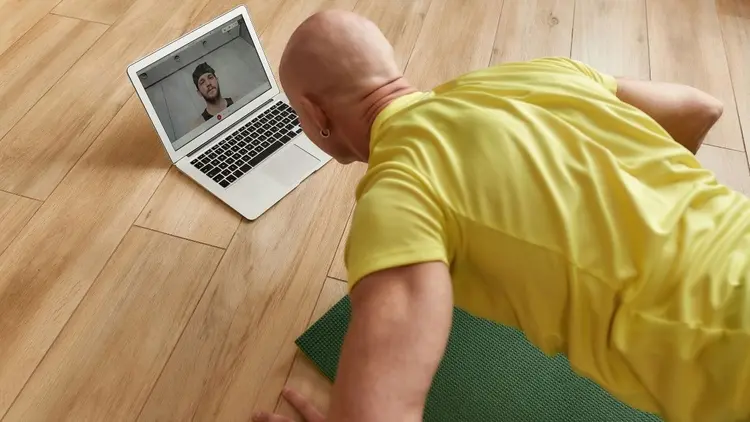

Hey there, fitness enthusiasts and budding entrepreneurs! Are you dreaming of turning your passion for fitness into a thriving online business? Well, you’ve clicked on the right article. Today, I’m going to walk you through the exciting journey of creating your first online fitness course.
From concept to launch, we’ll cover everything you need to know to make your course a resounding success.

Before we dive in, let’s talk about time – how long does it take to develop an online course? There’s no one-size-fits-all answer here. It can take anywhere from a few hours for a mini course to several months for an in-depth flagship course. The key is understanding that creating courses, especially your first online course, is a process that requires dedication. Think of it as a marathon, not a sprint.
Embarking on the journey of creating an online fitness course begins with a pivotal question: What’s your specialty? The realm of “fitness” is vast and varied, encompassing everything from bodybuilding and powerlifting to yoga, Pilates, and high-intensity interval training (HIIT). Your mission, should you choose to accept it, is to carve out a niche that not only resonates with your expertise and passion but also addresses a specific need or gap in the market.
Conducting exhaustive market research is your first step towards enlightenment. Dive deep into existing online course platforms and analyze their offerings. What courses are in high demand? Where does the competition seem light, and what topics are oversaturated? This exploration serves a dual purpose: it sharpens your understanding of the target audience’s preferences and sheds light on untapped opportunities. For instance, you might discover a burgeoning interest in holistic fitness programs that blend physical training with mental well-being practices, a niche with growing appeal.
Additionally, consider the current trends and how they might influence your course’s relevance and longevity. Are wearable fitness devices influencing how people train? Is there a rising interest in nutrition as part of a comprehensive fitness regime? These insights can help you refine your course concept to ensure it’s both timely and timeless.
The #1 to make money online with TikTok Search (FREE TRAINING)

With a potential course topic in hand, the next step is validation. This crucial phase is about ensuring there’s a real demand for your course, saving you from the heartache of launching to crickets. Start by engaging directly with your potential audience.
Social media platforms, fitness forums, and even local gym communities can be goldmines of information. Pose questions, start discussions, and gauge the enthusiasm and needs of your prospective students.
Surveys are another potent tool in your validation arsenal. They can provide quantitative data that supports your qualitative findings from discussions and observations. Tools like SurveyMonkey or Google Forms can help you construct concise, targeted surveys that inquire about people’s fitness goals, their preferred learning formats, the challenges they face in achieving their fitness aspirations, and what they look for in an online course.
Don’t overlook the power of existing content, either. Blogs, YouTube channels, and fitness podcasts can offer insights into what content resonates with your audience. Which topics get the most engagement? What questions are people asking in the comments? This can help you identify not just course topics but also specific content angles and questions that your course should address.
Remember, a successful online course doesn’t just disseminate information—it solves a problem or fulfills a specific need. Your validation process should confirm that your course concept does exactly that.
It’s not just about finding a niche; it’s about finding a niche with an eager audience waiting for the solutions you can provide. This stage is about listening, learning, and iterating until you’re confident that your course has the potential to make a real impact.

Diving deeper into the creation of your online fitness course, the development of a detailed course outline marks a critical phase. This isn’t just about jotting down a few ideas on paper; it’s about architecting an educational journey that guides your students from where they are to where they want to be. A robust course outline acts as your roadmap, ensuring that every piece of content you create serves a purpose and moves your students closer to their goals.
Begin by establishing clear, measurable learning objectives. What exactly will your students be able to do by the end of your course? These objectives should be specific, attainable, relevant, and time-bound (SMART). They not only inform your course structure but also help keep your content focused and your students motivated.
Next, break down your course into manageable modules or sections, each addressing a specific aspect of the broader course topic. This structure should be logical and progressive, enabling students to build on what they’ve learned in previous sections. Within each module, outline the key concepts, skills, and knowledge that you will cover. Consider incorporating a mix of theoretical lessons, practical exercises, and case studies to provide a holistic learning experience.
For an in-depth guide on crafting a cohesive course outline, complete with examples and best practices, this resource is invaluable. It will walk you through the process of translating your course idea into a structured and engaging learning path.
With your detailed outline as a foundation, it’s time to bring your course to life by developing the actual course materials. This stage is where your creativity and expertise shine as you create content that not only educates but also engages and inspires your students.
Your course materials should cater to a variety of learning styles. Some students may prefer reading detailed written materials, while others might benefit more from visual aids like infographics or video content. Therefore, aim to diversify your content types. Here’s how you can do it:
Remember, variety is indeed the spice of life, and in the context of online course creation, it’s the key to crafting an engaging, effective learning experience. By mixing up your content types and teaching methods, you ensure that your course appeals to a broad audience and meets the needs of different learners.

In the bustling digital landscape of online fitness programs, the caliber of your video content can set you apart. High-quality videos are not just a preference; they’re a necessity. They convey professionalism, enhance clarity, and significantly improve the student’s learning experience. However, achieving this doesn’t necessarily mean breaking the bank with expensive equipment. The focus should be on smart investments and best practices to ensure your videos meet a professional standard.
Here are key areas to focus on:
For those looking to dive deeper into the art and science of video production, exploring an SEO course on content creation can provide valuable insights into making your videos more discoverable and engaging.
Creating a connection with your audience goes beyond just delivering content; it’s about building a community and fostering a sense of belonging among your students. Personal touches can transform a standard online fitness course into an immersive and memorable learning experience.
Share Personal Anecdotes: Your journey, challenges, and achievements can inspire and motivate your students. Sharing these stories makes you more relatable, encouraging students to engage more deeply with the course material.
Incorporate Voice Memos: Adding voice memos to your presentations or workout plans adds a layer of personal interaction that text and video alone cannot achieve. It’s like having a one-on-one conversation with each of your students, providing encouragement or explaining concepts in a more intimate manner.
Interactive Sessions: Live sessions or webinars provide real-time engagement opportunities. They allow for immediate feedback, Q&A, and personal interaction, which can significantly enhance the sense of community within your online fitness program. These sessions can be used to address common challenges, share success stories, or even conduct live workouts.
Feedback and Customization: Encourage feedback from your students and use it to tailor the course. This could mean adjusting the pace, focusing on areas where many students struggle, or adding content based on student interest. Customization makes the learning experience more relevant and engaging for each student.
By focusing on these aspects, you can ensure that your online fitness courses are not just informative but also deeply engaging and personal. Remember, the goal is to not only educate but to inspire and motivate your students to achieve their fitness goals.

In the dynamic world of the online fitness industry, the platform you choose to host your online personal training business can significantly impact its success. It’s not just about finding a place to upload your content; it’s about selecting a digital environment that supports your vision, facilitates engagement, and enhances the learning experience for your target audience.
The ideal online training platform for your course should offer an all-in-one solution, encompassing not just content hosting but also features like payment processing, user analytics, marketing tools, and customer support. These integrated platforms simplify the operational aspects of running your online course, allowing you to focus more on content creation and student engagement.
When evaluating platforms, consider the following:
User Experience: The platform should be intuitive for both you and your students. Easy navigation, seamless video playback, and straightforward access to course materials are essential for keeping students engaged.
Customization and Branding: Look for platforms that allow you to customize the look and feel of your course. Being able to brand your course pages and materials helps in creating a unique identity for your online personal training business within the crowded online fitness industry.
Community Features: Engagement goes beyond course content. Platforms that offer forums, discussion boards, or group features can help foster a community among your students, enhancing their learning experience and loyalty to your brand.
Scalability: As your business grows, your platform needs to be able to grow with you. Whether it’s adding more courses or accommodating more students, ensure the platform can scale to meet your expanding needs.
Mobile Accessibility: With many users accessing content on-the-go, the platform’s mobile responsiveness is crucial. Ensure that your course looks and functions well on various devices, including smartphones and tablets.
Before officially launching your online personal training business to the wider public, conducting a beta test is a strategic move. Select a small group from your target audience to go through your course. This group can provide invaluable feedback on various aspects of the course, such as the clarity of your content, the effectiveness of your teaching methods, and the user-friendliness of the platform.
This feedback loop is essential for several reasons:
After gathering this feedback, take the time to make the necessary adjustments. This might mean tweaking your course content, changing how information is presented, or even switching platforms if your current choice doesn’t meet your needs or those of your students.
Launching an online personal training business in the thriving online fitness industry requires not just passion and knowledge but also strategic planning and execution. Choosing the right platform and refining your course through beta testing are crucial steps in this journey, setting the foundation for a successful and impactful online training program.

Launching your own online fitness business is an exciting journey, but the real challenge often begins when it’s time to market and sell your fitness program online. To turn your passion into profit, you need a strategic approach that not only highlights the value of your workout program but also effectively reaches and convinces your target audience.
Your sales page is the gateway to your course. It’s here that potential customers decide whether your fitness program online is right for them. To make your sales page compelling, focus on the unique benefits of your program. How does it stand out from other fitness programs online? Does it offer a unique approach to workout routines, or perhaps it’s designed by fitness professionals with years of experience? Highlight these unique selling points prominently.
Testimonials play a crucial role in building trust. Featuring success stories and positive feedback from past participants can significantly boost your credibility. If possible, include before-and-after photos, video testimonials, and detailed accounts of how your program has made a difference in people’s lives.
In addition to showcasing the benefits and testimonials, ensure that your sales page is visually appealing and easy to navigate. Use clear, motivating calls to action (CTAs) that guide visitors towards making a purchase.
To sell fitness programs online effectively, you need a multifaceted marketing plan that leverages the power of various channels:
The #1 to make money online with TikTok Search (FREE TRAINING)

Setting the right price for your workout program is critical. It needs to reflect the value you’re providing while remaining accessible to your target audience. Consider employing a tiered pricing model to cater to different segments of your market. For example, you could offer a basic version of your course at a lower price point, a standard version with additional resources in the mid-range, and a premium package that includes one-on-one coaching sessions for those willing to invest more in their fitness journey.
Alternatively, introducing a free module or trial period can serve as a risk-free way for potential customers to experience your course firsthand. This approach can build trust and demonstrate the value of your full program, making them more likely to commit to a purchase.
By meticulously crafting your sales page, executing a diversified marketing strategy, and thoughtfully pricing your fitness program, you can successfully sell your online fitness courses and grow your own online fitness business.

The moment has arrived – it’s time to unveil your online fitness course to the world. Launching your course is a significant milestone in your journey as a creator and entrepreneur. This is when your hard work starts to pay off as students begin enrolling and engaging with your content. However, the launch is just the beginning of a new chapter.
A successful launch strategy might include a special introductory offer, a live kickoff event, or a series of engaging social media posts to generate buzz. Remember, the goal is to make your course’s debut as impactful as possible, attracting initial students and setting the tone for future growth.
After the excitement of the launch fades, the real work of cultivating and maintaining a vibrant learning community begins. Ongoing engagement with your students is crucial for the long-term success of your online fitness course. Regularly interacting with students through forums, live Q&A sessions, and feedback surveys can help you understand their needs, challenges, and achievements.
Collecting and acting on feedback is a vital part of this phase. Use it to refine and improve your course content, addressing any gaps or areas where students are struggling. This continuous improvement cycle ensures that your course remains relevant, valuable, and engaging.
Moreover, the fitness industry is dynamic, with new trends, techniques, and research emerging regularly. Staying abreast of these developments and updating your course to reflect the latest information and best practices is essential. This not only enhances the learning experience but also reinforces your credibility as an expert in your field.
Additionally, consider expanding your course offerings to keep your content fresh and your students engaged. This could mean adding advanced modules, supplemental mini-courses, or even entirely new courses that build on the knowledge your students have gained.
Beyond the course itself, think about how you can expand and scale your online fitness business. Developing a content marketing strategy, leveraging student testimonials, and exploring additional revenue streams like personalized coaching services, fitness eBooks, or branded merchandise can further enhance your brand and business growth.
In essence, launching your course is just the start. The journey of an online course creator is cyclical, revolving around launching, engaging, updating, and expanding. By embracing this ongoing process, you can ensure that your online fitness course not only achieves initial success but also grows, evolves, and thrives over time.

Launching an online fitness course is an exciting journey filled with learning and growth. Remember, your unique approach and dedication are what will make your course shine in the fitness industry. So, go ahead, create that course, inspire people, and watch your online fitness business thrive!
For more insights and detailed guidance on monetizing your passion and creating engaging online courses, don’t forget to check out these valuable resources:
Embark on your journey with confidence and create an online fitness course that not only educates but also inspires and transforms lives. The online fitness world awaits your unique contribution!





